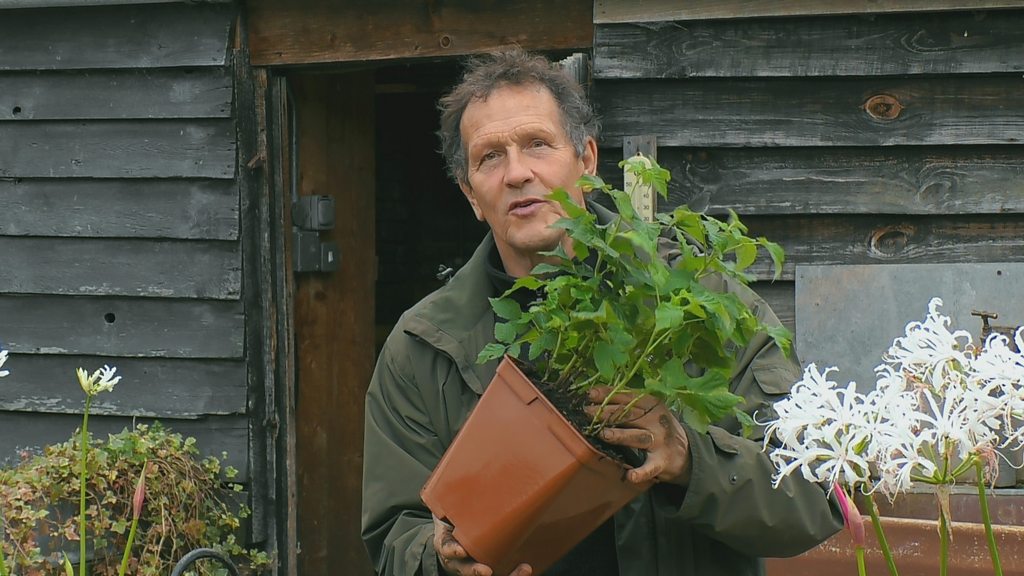Gardeners’ World 2021 episode 9: At Longmeadow, Monty revels in seasonal blossom and flowers, plants out his tomatoes and demystifies the myriad of different plant foods by showing us what we can feed our plants and when we should be doing it.
Arit Anderson visits the peatlands of Cumbria, where she begins her journey looking into the use of peat in the horticultural industry. We catch up with Sue Kent to find out about the progress she has made on her allotment and in her garden this spring.
In Wales, we meet a gardener who has amassed a collection of over 400 different rhododendrons.
Gardeners’ World 2021 episode 9
Camellia
Camellias are one of the most popular winter- and spring-flowering shrubs, providing a vivid splash of colour when little else is in bloom. Although they need acid soil, they are easy to grow in containers of ericaceous (acidic) potting compost.
Camellias are woodland plants that grow best in shelter and light shade, although with careful watering they can be grown in sunny positions. They prefer free-draining conditions, with plenty of organic matter, such as leaf mould, incorporated into the soil. Being ericaceous plants, camellias require an acid soil. If your soil isn’t acid then consider growing your camellia in a container.
Tap water, especially in hard water districts, often contains too much calcium for camellias, reducing the acidity around the roots over time. Rain water is ideal for watering camellias. If rain water runs out, tap water is satisfactory for a month or two in summer.
Feed camellias in spring and early summer with acidic fertilisers, such as Chempak Ericaceous, Miracle-gro Ericaceous, sulphate of ammonia or sulphate of potash. Controlled release fertiliser pellets are available from Miracid and Phostrogen to mix into the potting compost of container-grown plants, avoiding the need for further feeding until the following season.
You can use organic-based fertilisers, including seaweed products and fish, blood and bone. It should be noted, however, that fish, blood and bone is mildly alkaline (because of the calcium in the bone) so it would be best not to use where the soil is pH of 7 or above (neutral to alkaline) as this could encourage deficiencies such as chlorosis. To be clear, though, annual applications are unlikely to cause much problem and, where the pH is increased, the soil could be acidified to compensate for applying this useful fertiliser.
Bog gardens – Gardeners’ World 2021 episode 9
Creating a bog garden is the perfect use for a redundant or leaky pond, but it can also be an informal edge to an existing pond or a way of cultivating a naturally waterlogged dip in your garden. Bog gardens provide a range of attractive planting opportunities and are an excellent wildlife habitat.
Small areas are generally easier to create and maintain as a bog garden. Larger areas need to have stepping stones or walkways incorporated into the design to allow access for maintenance.
Creating a bog garden is an ideal method for converting an existing garden pond, or adding a bog area to the edge of a new pond, as the same pond liner can be used underneath the bog garden to create waterlogged conditions. Holes are pierced into the liner and a layer of gravel placed in the bottom to allow for some drainage, so that conditions are waterlogged without pooling.
Dahlia
Dahlias are invaluable for the summer border, in patio containers or as cut flowers, often flowering until the first frosts. With many excellent recent introductions, they offer a wide range of flower types, often with very showy, double forms in warm vibrant colours. Dahlias are enjoying a much deserved return to popularity.
Dahlias are easy to grow but do need winter protection in most parts of the UK. They are tolerant of a wide range of soil types and situations but best planted in fertile, well-drained soil in full sun when danger of frost is over, usually May to early June. Planting could be carried out slightly earlier in southern counties or later in the north of England and Scotland.
Cut plants to the ground after the first frosts have blackened the foliage. In mild regions and on well-drained soils, leave the tubers in the ground and cover with a 7.5-15cm (3-6in) deep layer of bark chips or garden compost to protect them from frost. In colder areas or on heavy soils, lift and store the tubers (see below) and replant the following spring.
Rhododendron – Gardeners’ World 2021 episode 9
Rhododendrons are grown for their spectacular flowers, usually borne in spring. Some also have young leaves and stems covered in a striking dense woolly covering (indumentum) and some – the deciduous rhododendrons or azaleas – have good autumn colour.
Choose a site with dappled shade in sheltered conditions. Avoid deep shade beneath other trees. Most rhododendrons will tolerate a more open site if sheltered from cold, dry winds. Dwarf alpine species will tolerate full sun provided the soil does not dry out. Avoid frost pockets and sites exposed to early morning sun.





Pingback: Gardeners’ World 2017 episode 6 — HDclump — Gardeners' World 2017
Pingback: Gardeners’ World 2021 episode 10 — HDclump — Gardeners’ World 2021